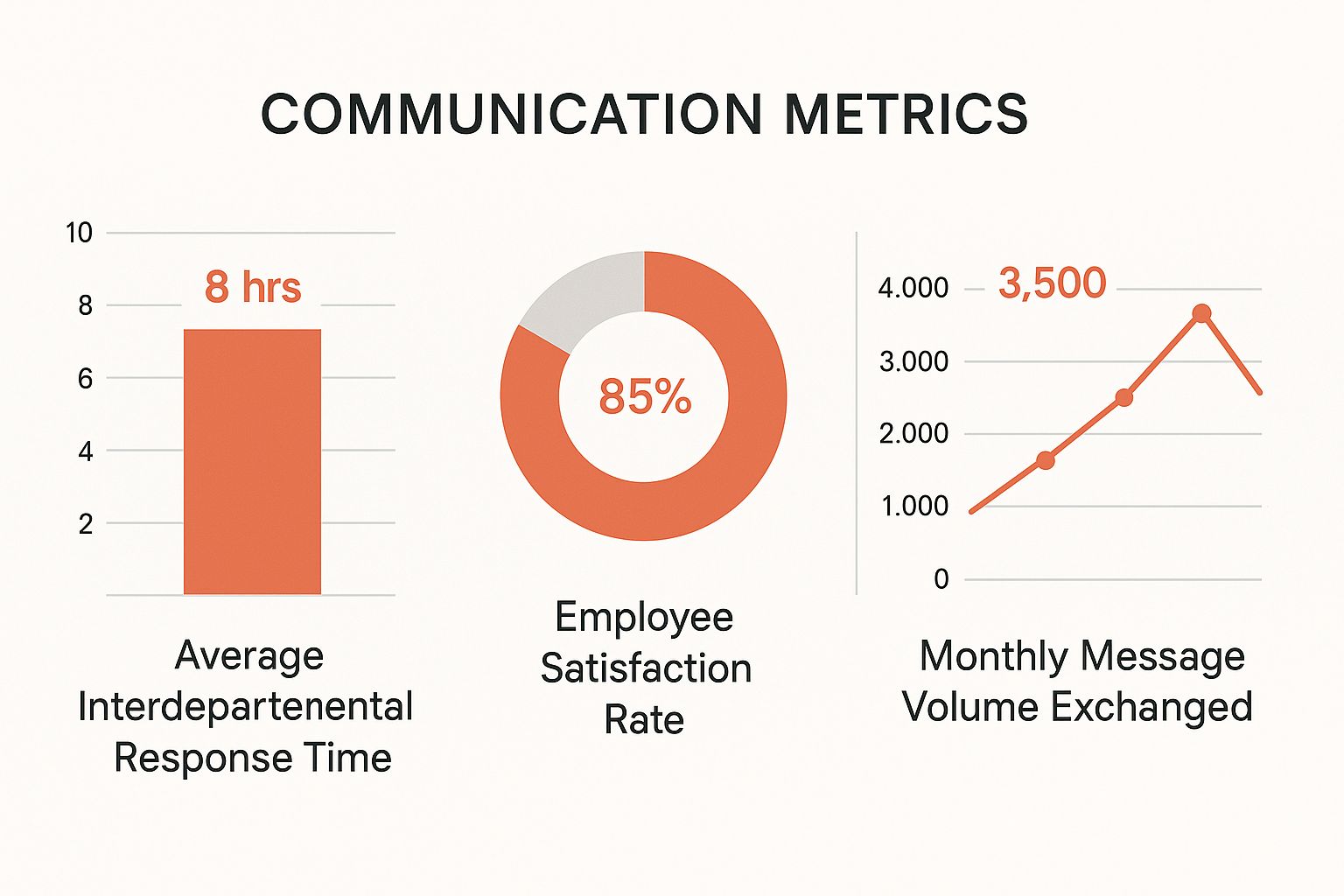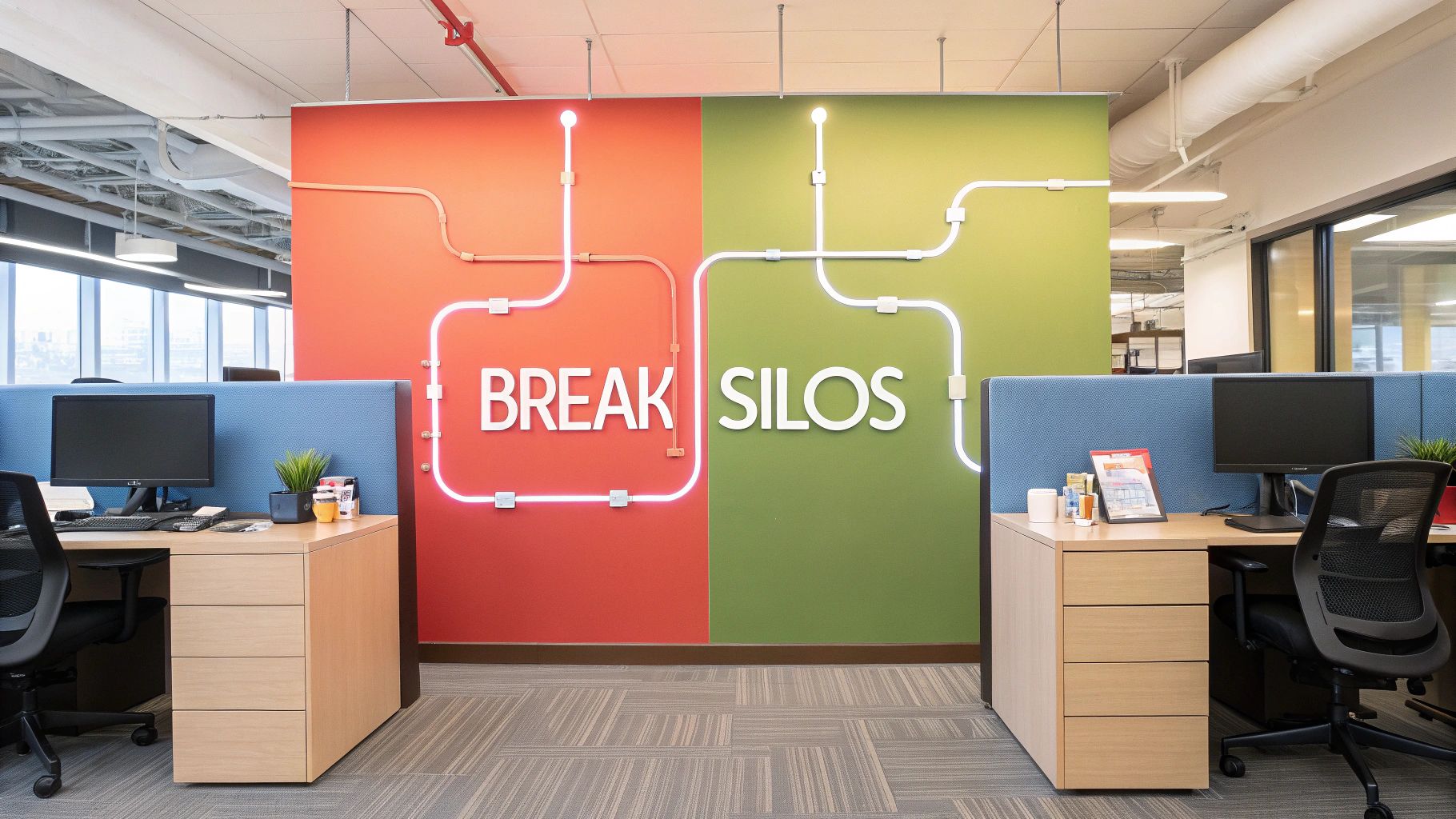When you boil it down, inter-departmental communication is just the way different teams inside your agency talk to each other and work together. It's what keeps your sales team, your creative geniuses, and your account managers all on the same page, pulling in the same direction to deliver amazing results for your clients.
Why Departmental Silos Are Costing Your Agency Clients and Talent

Let's be real—when your creative, accounts, and sales teams aren't talking, it’s not just a minor headache. It's a direct hit to your bottom line. In the agency world, a smooth flow of information isn't just a "nice-to-have"; it's a fundamental operational advantage that separates the thriving agencies from the struggling ones.
Think of your agency as a high-stakes relay team. Each department—sales, strategy, creative, project management—is a runner. It doesn't matter how fast each individual is if the handoff is clumsy. A fumbled baton, like a client brief that gets lost in translation, costs you momentum, precious time, and ultimately, the client's trust.
The Hidden Costs of Disconnected Agency Workflows
When departments become silos, the fallout spreads like wildfire across the entire agency. We're not talking about small slip-ups; we're talking about deep, systemic issues that eat away at your profitability and client relationships. These are the problems that keep agency owners up at night.
Sound familiar? These pain points are everywhere in the agency world:
- Wasted Creative Cycles: The design team spends weeks on a brilliant campaign, only to discover it completely missed a crucial goal the client mentioned to the account manager in a passing comment. Back to the drawing board.
- Unrealistic Sales Promises: An eager salesperson closes a huge deal by promising a feature or a lightning-fast timeline that the delivery team simply can't execute without pulling all-nighters for a month.
- The Dreaded Revision Loop: The gap between what was sold and what is being built creates an endless cycle of client feedback and rework, absolutely demolishing your project profit margins.
Ineffective communication is the single biggest roadblock to agency efficiency. Closing these gaps is the most direct path to turning internal friction into a unified force that wins and keeps clients.
At the end of the day, poor inter-departmental communication means your teams spend more time putting out internal fires than delighting clients. This constant state of reactive chaos stifles strategic growth, burns out your best people, and creates an environment where nobody can truly shine.
Diagnosing Your Agency’s Specific Communication Barriers
Does it ever feel like your creative team is speaking a completely different language from your sales department? You’re not just imagining it. Poor inter-departmental communication is rarely a single, obvious problem; it's a web of hidden roadblocks that quietly sabotage your agency's workflow and halt momentum.
Moving past the generic buzzword "silos" is the first step. To actually fix the problem, you need to diagnose the specific barriers causing the disconnect. These issues often fall into distinct categories, each creating its own unique brand of chaos within an agency setting.
How Tech Stacks Create Information Gaps Between Teams
One of the most common—yet often overlooked—barriers is structural. This is what happens when your agency’s tools and processes simply don’t talk to each other. For instance, the sales team lives in their CRM, meticulously tracking every client conversation and deal stage. Meanwhile, your project managers operate from a completely separate platform where project scope and deliverables are managed.
This setup creates an information black hole. When a project is handed off, crucial context about the client's initial goals and expectations never makes the jump from the sales system to the delivery system. The result? A delivery team starting with one hand tied behind their back, trying to piece together a puzzle that’s missing half its pieces.
The Problem with Competing Departmental KPIs
Another huge barrier is cultural, and it’s usually rooted in competing departmental goals. Your sales team is incentivized with commissions to close deals—the bigger, the better. At the same time, your delivery and account management teams are measured on project profitability, client retention, and staying within the agreed-upon scope.
This inherent conflict creates friction. Sales might oversell features or promise tight deadlines to secure a win, putting immense pressure on the delivery team to perform miracles. This misalignment means teams aren't really working together; they're working against each other's key performance indicators, which inevitably leads to burnout and those dreaded "why wasn't this in the scope?" client calls.
A significant satisfaction gap exists between different types of employees regarding internal communication. Only 29% of non-desk employees feel satisfied with communication quality, compared to 47% of desk employees, a divide that can impact retention and leadership effectiveness. Discover more insights about the importance of inclusive communication from a recent study.
Identifying these disconnects is the critical first step. Once you've pinpointed the specific challenges your agency faces, exploring proven strategies to overcome communication barriers can provide a clear path forward. Without getting to the root cause—whether it’s a broken process, misaligned incentives, or a simple lack of shared knowledge—any attempt to improve communication will only ever be a temporary fix.
Building a Unified Communication Framework for Your Agency

Spotting communication breakdowns is the easy part. The real work—the kind that sparks genuine agency growth—is building a system that stops them from happening in the first place.
Think of a unified framework as your agency’s central nervous system. It intentionally directs how information flows between your teams, moving you out of a constant firefighting mode and into a proactive, strategic operation where everyone is on the same page.
This isn’t about cramming more meetings onto the calendar. It’s about creating purposeful, structured touchpoints and shared resources that make inter-departmental communication a natural part of the daily workflow, not a frantic afterthought.
Assemble Cross-Functional "Client Pods"
The first, most impactful step is to dismantle the traditional departmental structure by creating small, dedicated teams focused entirely on client success.
Picture this: for each major account, you form a "Client Success Pod" with key players from accounts, strategy, creative, and maybe even finance. Their mission is singular and shared.
This model completely flips the script on team motivation. Instead of chasing isolated, department-specific KPIs—like the number of ads designed or deals closed—the entire pod shares one overarching goal: the client's success and retention. That shared objective naturally forces collaboration and dissolves the "us vs. them" mentality that so often pits departments against one another.
The core idea is simple but powerful: When everyone is responsible for the final outcome, they are more invested in helping each other succeed along the way. Silos can't survive in an environment of shared ownership.
This team-based approach is quickly becoming the new standard. A rising trend is the creation of an 'EX Super Team'—a cross-functional group of leaders from HR, IT, and internal comms. They collaborate with shared objectives to improve the employee experience, balancing human needs with technical solutions. You can learn more about how this trend is reshaping workplace transformation.
Create a Single Source of Truth for Every Client
For any unified framework to actually work, everyone needs to be speaking the same language. That means standardizing the basics: project terminology, brief templates, and reporting formats across the entire agency. When "urgent" means the same thing to a designer as it does to an account manager, you eliminate a massive, unnecessary source of friction.
Of course, this universal language needs a home. A centralized information hub is non-negotiable, whether it's a project management tool like Asana, a shared drive, or a dedicated internal wiki. This becomes your single source of truth for everything related to a client, housing crucial assets like:
- Initial Discovery and Sales Notes: The full context behind why the client came to you.
- Official Project Briefs: The finalized scope and objectives everyone has agreed upon.
- Key Client Communications: Summaries of important calls and decisions.
- Final Deliverables and Feedback: A complete history of the work produced.
When all this information lives in one place, anyone from any department can get up to speed on a project without having to chase down three different people for four different documents. It makes your entire agency more resilient, efficient, and ultimately, more cohesive.
Selecting the Right Tech Stack for Agency-Wide Collaboration
The technology your agency uses can either be the glue that holds your teams together or the very thing that drives them apart. When it comes to effective inter-departmental communication, the right tools aren't just helpful—they're essential. But just throwing a bunch of popular apps at your team without a game plan can cause more problems than it solves, leading to confusion, tool fatigue, and a lot of digital noise.
The secret is to give every tool a specific job. It's about creating a simple, clear "what to use when" guide for everyone in the agency. This one step removes the daily guesswork that causes important messages to get buried in the wrong channel. When people know exactly where to go for what, communication flows naturally.
Think of it this way: a clear policy defines the purpose of each communication method, making sure your teams are always using the right tool for the right job.
The data below shows just how much a well-planned communication strategy can affect key agency metrics, drawing a direct line between the tech you use and your team's overall performance.

It's pretty clear from this visual that when you get a handle on message volume and response times by using your tools wisely, employee satisfaction climbs right alongside it.
Assigning a Specific Job to Each Communication Tool
To stop the chaos before it starts, every communication channel needs a clear, defined purpose. Your team shouldn't have to pause and wonder, "Should I send this quick question over Slack or in an email?" A solid, structured approach might look something like this:
Instant Messaging (like Slack or Microsoft Teams): This is your agency's virtual water cooler and fast-lane. Use it for quick-fire feedback, urgent updates, and those informal back-and-forth conversations that don't need a formal paper trail. Think of it as the place for real-time collaboration.
Email: Keep email for the important, official stuff. It's perfect for formal client communication, final project approvals, and sending documents that need to be recorded and easily found later. Email creates that necessary digital paper trail.
Project Management Platforms (like Asana or monday.com): This is your agency's command center—the single source of truth. All project briefs, creative assets, task assignments, deadlines, and status updates must live here. It keeps everyone, from creative to accounts, perfectly aligned on what needs to happen and when. For more insights on this, check out our guide to the top agency project management tools.
Deciding which channel to use for what scenario is a common headache in agencies. Here’s a quick breakdown to help clarify the strengths and weaknesses of each.
Agency Communication Channel Effectiveness Matrix
As the matrix shows, there’s no single "best" tool—only the best tool for a specific task. A healthy mix is what keeps an agency running smoothly.
The Irreplaceable Value of Synchronous All-Hands Meetings
While day-to-day work happens in apps and on platforms, you can't replace the impact of getting everyone together at the same time. Synchronous channels, especially all-hands meetings, are absolutely vital for big-picture alignment. There’s simply no better way to roll out a major strategic shift, celebrate a huge win, or reinforce the company culture across every single department.
The numbers back this up. While email is used by 92% of employers, more interactive formats like all-employee live events score an even higher effectiveness rating, hitting 97%. This just goes to show the massive impact of bringing teams together in real-time.
By giving every tool a clear role—from a quick Slack message to a company-wide town hall—you provide the structure people need for communication to feel effortless. This ensures your technology is actually helping people collaborate, not accidentally making it harder.
How to Automate Key Communication Touchpoints

Even with the best tools and processes in place, communication breakdowns often happen in the quiet moments between conversations. Think about it. An account manager wraps up a client call and then has to translate their scribbled notes into a coherent brief for the creative team. That manual handoff is where crucial details get lost in translation.
This is exactly the kind of bottleneck that modern technology can eliminate. By introducing smart automation, you can create a direct link from client conversation to project execution, making sure nothing gets misinterpreted or forgotten. It’s not about replacing people, but about giving them a reliable system that strengthens their work and improves inter departmental communication.
Let’s walk through a typical agency workflow, but with one game-changing twist. Your account manager finishes a strategy call with a client. Immediately, an AI tool like Scribbl kicks into gear.
From Client Call to Actionable Brief in Minutes
Instead of spending the next hour trying to decipher messy notes and draft a recap email, the AI instantly generates a concise summary of the entire call. It pulls out the most important decisions, pinpoints key client feedback, and creates a clean, organized list of action items. This isn't just a word-for-word transcript; it’s an intelligent, usable record of the meeting.
That summary, along with its task list, is then automatically shared in the right Slack channel or Trello board. Suddenly, the creative, project management, and strategy teams aren’t getting a second-hand version of the story. They have a perfect, unbiased record of what the client actually said and what was agreed upon.
The real power of automation in communication is its ability to remove human error from the transfer of information. It creates a single source of truth that every department can rely on, ending the "he said, she said" confusion that so often derails projects.
This simple step ensures that everyone, from the project manager to the copywriter, is operating from the exact same information—straight from the source.
The Agency-Wide Impact of Automated Handoffs
Putting this kind of automated workflow into practice has an immediate and tangible effect on how an agency runs. It directly tackles some of the most stubborn communication barriers.
- No More Misinterpreted Notes: The AI captures exactly what was said, wiping out the risk of important details being missed or misunderstood in translation.
- Fewer Back-and-Forth Clarifications: When the brief is crystal clear from the get-go, your creative team spends less time asking for clarification and more time producing amazing work.
- Instant Team Alignment: Every department is on the same page the moment a call ends, not hours or even days later when a manual summary finally makes the rounds.
This automated process transforms a high-risk communication gap into a dependable, efficient part of your workflow. For agencies aiming to build a more connected and effective operation, mastering https://scribbl.co/post/action-item-tracking with automation is a critical first step. By ensuring every task is captured and assigned correctly, you close the loop between discussion and delivery, paving the way for smoother projects across every team.
Fostering an Agency Culture of Proactive Collaboration
You can have the best software and the most refined workflows on the planet, but they’ll fall flat if your agency’s culture isn’t built for collaboration. Technology can build the bridges, but your team has to actually want to cross them.
Building a culture of connected work is about making strong inter departmental communication the default, not some forced corporate initiative. For agency leaders, this goes way beyond sending out memos or scheduling more meetings. It’s about creating an environment where working together feels natural, easy, and even rewarding.
It all starts with small but powerful rituals that begin to tear down the invisible walls between teams.
Weaving Collaboration into Your Agency's Daily DNA
Let's start at the very beginning of a project. Instead of the typical linear handoff—where a project file gets passed from sales to accounts to creative like a hot potato—try implementing cross-departmental kickoffs from the jump. Get sales, strategy, and creative in the same room from day one. This simple act ensures everyone hears the client’s vision firsthand, which gets goals aligned before a single hour is ever billed.
Another great tactic is creating shared learning opportunities. You could host regular "lunch and learn" sessions where a developer breaks down a new technical capability for the account managers. Or maybe a strategist walks the design team through some fascinating new market research. These moments build mutual respect and a much deeper understanding of what everyone else actually does all day.
To get a truly connected work environment humming and tackle common communication hurdles, digging into some effective team communication strategies can offer some incredibly useful frameworks.
The goal is to make collaboration a habit. When teams understand and value each other’s contributions, communication shifts from a task to a tool for collective success.
Finally, celebrate wins as a whole agency, not just as departmental victories. When a campaign crushes its goals, make a point to highlight how sales' initial insights, strategy’s brilliant plan, and creative’s flawless execution all came together. This constantly reinforces the idea that no one succeeds alone.
For more ideas on this, check out our guide on how to improve team collaboration. Taking these steps helps embed teamwork right into your agency's DNA, making it part of who you are, not just something you do.
Common Inter-Departmental Communication FAQs for Agencies
If you're an agency leader, you've likely spent a lot of time thinking about how your teams talk to each other—or don't. We hear the same questions pop up again and again. Here are some quick, no-fluff answers to the most common communication headaches we see.
How Can We Fix the Disconnect Between Our Sales and Delivery Teams?
It’s the age-old agency story: sales promises a grand vision, and the delivery team is left holding the bag, trying to figure out how to make it a reality. The most effective fix is to formalize the handoff process.
Make a "Sales-to-Service Handoff" meeting mandatory for every new client. No exceptions. The sales team should fill out a standardized project brief, and the delivery team must review and formally sign off on it before a single hour is logged. This creates a moment of accountability that forces everyone to get on the same page about scope, client expectations, and what was actually promised.
What Is the Best Tactical Way to Break Down Departmental Silos?
Silos aren't just invisible walls; they're the natural result of competing departmental goals. If you want to tear them down, you have to give people a bigger, shared goal to rally around.
The best way to do this is by creating cross-functional "client pods" or "squads." Instead of having separate departments for accounts, strategy, and creative, you build small, dedicated teams that are collectively responsible for a specific client.
This simple shift changes everything. The team's focus moves from hitting internal KPIs to achieving client success. When everyone's fate is tied to retaining and growing an account, real collaboration isn't just a nice-to-have; it's a survival mechanism.
How Do We Improve Communication With a Remote or Hybrid Agency Team?
When your team is scattered across the globe, synchronous communication like video calls can become a bottleneck. The key is to shift your mindset to asynchronous communication and establish a single source of truth.
Choose a project management platform—like Asana or Monday.com—and make it non-negotiable that all major decisions, client feedback, and status updates are documented there. This ensures that critical information isn't lost in a meeting someone couldn't attend. Tools that automatically summarize meetings are perfect for this, letting team members in different time zones catch up on key decisions and action items without scrubbing through an hour-long recording.
Ready to close the communication gaps for good and get your teams perfectly aligned? Scribbl automatically transcribes and summarizes client calls, pulls out key action items, and makes sure insights get to the right people instantly. Stop letting critical details slip through the cracks and start giving your team back hours every single week.




